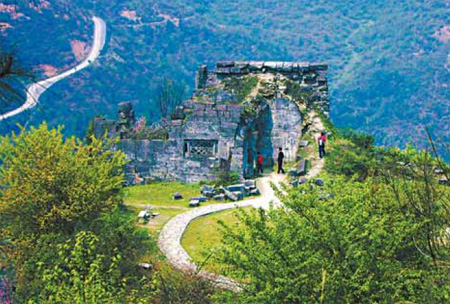Zunyi City in Guizhou province got its name from a line in the Book of History, one of the five classics of Chinese literature, written some time before the birth of Confucius (551-479 BC). The area’s history dates back even further, to the Palaeolithic ages, when it was home to the Tongzi people. Negotiating the space between the ancient Qin-Chu and Bashu civilizations, the wider Zunyi region has maintained a prominent position throughout Chinese history.
Formerly part of the territory of several ancient kingdoms, Zunyi is a mountainous city on the sloping terrain between the Sichuan Basin and the Yunnan-Guizhou Plateau. In the early Tang Dynasty (618-907) a prefecture known as Bozhou was founded here, but was subsequently wiped out in a war in 1601. The region was rebranded as “Zunyi” 400 years ago, and the name has stuck.
Warring Past
Hailongtun, or Ocean Dragon’s Castle, is a fortress on the cliffs of Longyan Mountain in northwest Zunyi. Built in 1257 during the Southern Song Dynasty by local magistrate Yang Wen, the 750-year-old construction defended the region against Mongolian forces, and continued to provide protection in the following Yuan (1271-1368) and Ming (1368-1644) dynasties. More than just a military garrison, the complex is in a sense a miniature ancient city, with a palace, ancestral temples, living quarters, a warehouse and a clinic. It was locally designed and built through collaboration between architects of diverse ethnic backgrounds, including Han, Miao, Gelao and Tujia, and hence stands out for its distinctive blending of architectural features.
The story of the rise and fall of the fortress is intertwined with that of the Yang family, which ruled the region for centuries. In the late Tang Dynasty Bozhou was overtaken by the neighboring Nanzhao regime, and Tang forces led by Yang Duan were sent in to win it back. After his victory, Yang Duan remained in the area to govern, marking the beginning of his family’s prominence. His son inherited his title.
In 1257 Mongolian forces approached Bozhou after conquering the neighboring Dali Kingdom. Incumbent governor Yang Wen applied to the Southern Song court to build a defense command, and got speedy approval. Hailongtun was thus erected.
In 1573 Yang Yinglong inherited the position of Bozhou governor from his father. The Ming Dynasty at the time had a lax policy towards regional officials in the southwestern regions, which it regarded as fringe ethnic minority backwaters. As long as regions sent the required tribute to the imperial court, local rulers were essentially given free rein to do as they pleased. With its fertile lands and plentiful harvest, Bozhou was coveted by warlords in both Sichuan and Guizhou. Backed by a sizable army, Yang Yinglong led an extravagant and kingly lifestyle and ruled with an iron fist. When he killed his wife following an altercation over his concubine, Guizhou officials reported him to the central authority, charging him with attempts to rebel, among other crimes. The Song emperor sent an army of 240,000 that besieged Hailongtun. After a bloody battle that lasted 114 days the imperial forces broke through Hailongtun’s rear fortifications. Yang Yinglong locked himself and two concubines in a room and set it alight. The imperial forces staged a massacre, decapitating more than 20,000 locals and ending the 725-year rule of the Yang family in the region.
Hailongtun was designated a provincial-level historical site in 1992, and was put under state protection in 2001. Work is now underway to put it on the world cultural heritage list.
 |
|
Ruins of the Hailongtun fortress tell of violence and gore of a bygone age when a chieftain and his army defied the iron will of the emperor.
|
We recommend:
